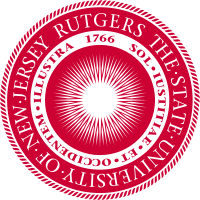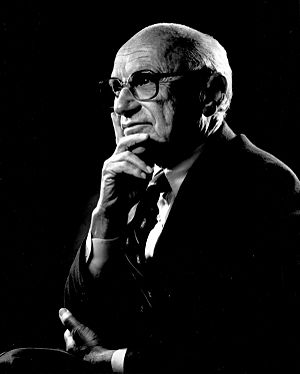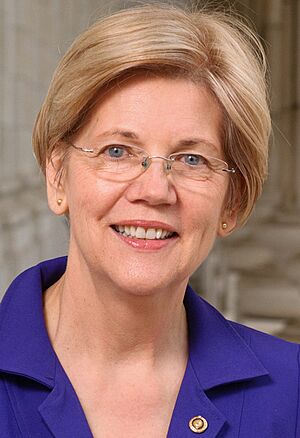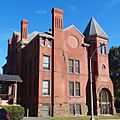Rutgers University facts for kids
|
Rutgers, The State University of New Jersey
|
|
 |
|
| Latin: Universitas Rutgersensis Civitatis Novae Caesareae | |
|
Former names
|
Queen's College (1766–1825) Rutgers College (1825–1924) Rutgers University (1924–1945) |
|---|---|
| Motto | Sol iustitiae et occidentem illustra (Latin) |
|
Motto in English
|
"Sun of righteousness, shine also upon the West." |
| Type | Private (1766–1945) Public land-grant research university |
| Established | November 10, 1766 |
| Accreditation | MSCHE |
|
Academic affiliation
|
|
| Endowment | $1.98 billion (2021) |
| Budget | $4.4 billion (2017–18) |
| President | Jonathan Holloway |
|
Academic staff
|
4,314 |
|
Administrative staff
|
6,757 |
| Students | 68,942 |
| Undergraduates | 49,359 |
| Postgraduates | 19,583 |
| Location |
,
,
United States
|
| Campus | Small City, 6,088 acres (2,464 ha) |
| Newspaper |
|
| Colors | Scarlet |
| Nickname | RU, Rutgers |
|
Sporting affiliations
|
|
| Mascot |
|
 |
|
Rutgers University, also known as RU, is a large public research university in New Jersey. It has four main campuses. Rutgers started in 1766 as Queen's College. It was connected to the Dutch Reformed Church back then.
Rutgers is one of the oldest colleges in the United States. It is the eighth-oldest overall and the second-oldest in New Jersey. It was one of nine colleges created before the American Revolution. In 1825, the college changed its name to Rutgers College. This was to honor Colonel Henry Rutgers, who gave a lot of money to help the school.
For many years, Rutgers was a private college focused on liberal arts. Later, it became a public university for both male and female students. This happened after New Jersey laws in 1945 and 1956 made it the official State University of New Jersey.
Today, Rutgers has four campuses: Rutgers University–New Brunswick, Rutgers University–Newark, Rutgers University–Camden, and Rutgers Biomedical and Health Sciences. It also has other places in the state, like research centers by the ocean.
Rutgers is a special kind of university. It is a land-grant, sea-grant, and space-grant school. This means it gets support from the government for research in farming, ocean studies, and space. It is the biggest university in New Jersey. About 9,000 teachers work there. They teach over 45,000 undergraduate students and more than 20,000 graduate students.
Contents
University Rankings
Rutgers became The State University of New Jersey by laws passed in 1945 and 1956. Its campuses are in New Brunswick, Piscataway, Newark, and Camden.
Rutgers is the largest university in New Jersey's state university system. In 2006, it was ranked 46th in the world for its academics. This ranking was done by Shanghai Jiao Tong University. The university offers many different study programs. You can choose from over 100 bachelor's degrees, 100 master's degrees, and 80 doctoral or professional degrees. These programs are offered across 175 academic departments and 29 schools.
Famous People from Rutgers
Many famous people have studied or taught at Rutgers University.
Notable Alumni


The first student to graduate from Queen's College (now Rutgers) was Matthew Leydt in 1774.
Rutgers graduates have done amazing things in many areas.
- Paul Robeson, a singer, athlete, and civil rights activist, graduated in 1919. There is a cultural center named after him at the university.
- Simeon De Witt (graduated 1776) became the Surveyor-General for the Continental Army during the American Revolutionary War.
- James Schureman (graduated 1775) served in the Continental Congress and as a U.S. Senator.
- Two alumni have won Nobel Prizes: Milton Friedman (1932) for economics, and Selman A. Waksman (1915, 1916) for medicine.
- Poet Robert Pinsky (1962) was named the nation's poet laureate.
- Novelist Junot Díaz (1992) won the Pulitzer Prize for Fiction in 2008.
Many alumni have held important government jobs.
- Seven alumni have been New Jersey governor.
- Garret Hobart (1863) served as Vice President of the United States.
- Louis Freeh (1971, 1974) was the director of the FBI.
- Frederick T. Frelinghuysen (1836) was a U.S. Senator and Secretary of State.
- Joseph P. Bradley (1836) was a justice on the Supreme Court of the United States.
- Diplomat Maria Fernanda Espinosa was the President of the United Nations General Assembly.
- Senators Elizabeth Warren and Bob Menendez both went to Rutgers Law School.
In business, famous alumni include:
- Bernard Marcus (1951), who started The Home Depot.
- Bill Rasmussen (1960), who founded ESPN.
- Duncan MacMillan (1966), who helped start Bloomberg L.P..
In science and technology, notable alumni are:
- Peter C. Schultz (1967), who helped invent fiber optics.
- Molecular geneticist Angela Christiano (1991).
- Geneticist Stanley N. Cohen (1956), who was a pioneer in gene splicing.
- Physician Howard Krein.
- Louis Gluck (1930), known as the "father of neonatology" (the study of newborn babies).
In entertainment, alumni include:
- Actor James Gandolfini (1983) from The Sopranos.
- Chef Mario Batali (1982).
- David Stern (1963), former commissioner of the National Basketball Association.
- Film director Henry Selick (The Nightmare Before Christmas).
- Actor Michael Sorvino.
- Author Holly Black.
- Actor Sebastian Stan (Captain America: The Winter Soldier).
- Voice actor John Dimaggio (Futurama, Adventure Time).
Notable Faculty
Rutgers has over 9,000 full-time and part-time teachers. Many of them have received top awards in their fields.
- Former law professor Ruth Bader Ginsburg (1933–2020) became a justice on the Supreme Court of the United States.
- David Levering Lewis, a history professor, won the Pulitzer Prize for Biography or Autobiography twice for his biography of W. E. B. Du Bois.
- Michael R. Douglas, a leading string theorist, won the Sackler Prize in theoretical physics.
- Chef and restaurateur Maricel Presilla taught history at Rutgers.
- Actor Avery Brooks, a Rutgers graduate, taught at the Mason Gross School of the Arts.
- Literature scholar Ankhi Mukherjee won the Rose Mary Crawshay prize.
- Jerry Fodor, Zenon Pylyshyn, Stephen Stich, and Frances Egan won the Jean Nicod Prize in philosophy and cognitive science.
As of 2013, 37 science, engineering, and medical teachers were members of the four "National Academies." These are very respected groups like the National Academy of Sciences.
Images for kids
-
Old Queens, the oldest building at Rutgers University in New Brunswick, New Jersey, built between 1809 and 1825. Old Queens houses much of the Rutgers University administration.
-
Oil painting of Revolutionary War hero and philanthropist, Colonel Henry Rutgers (1745–1830), early benefactor and namesake of Rutgers University
-
Placed on the western end of Voorhees Mall, a bronze statue of William the Silent commemorates the university's Dutch heritage.
-
New Jersey Hall on the New Brunswick College Avenue Campus was the home of the Agricultural Experiment Station, Biology and Chemistry faculty. It now houses the university's Department of Economics.
-
Prof. Selman A. Waksman (B.Sc. 1915), who was awarded the Nobel Prize in Medicine for developing 22 antibiotics—most notably Streptomycin—in his laboratory at Rutgers University
See also
 In Spanish: Universidad Rutgers para niños
In Spanish: Universidad Rutgers para niños
























